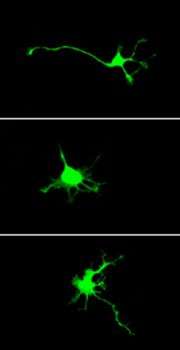Protein is linked to functional development of brain neurons
Rockefeller University investigators say that a molecule that helps transport cargo inside nerve cells may have another, critically important, role related to how developing neurons sprout the projections that relay electrical signals within the brain.
In the June 6 issue of The EMBO Journal, researchers in the Laboratory of Molecular Biology and Biochemistry, led by Tom Sakmar, discovered that a protein known as Tctex-1 must be present and coupled with another molecule, a subunit of a “G” signaling protein called Gβγ, before an embryonic neuron can grow its axon or dendrites.

They say this is a surprisingly important role for Tctex-1, which has been known primarily for its role in the dynein motor complex, which helps transport cargo along microtubule “avenues” inside neurons.
“Discovering that the interaction between Gβγ and Tctex-1 regulates neuronal development provides us with a new way about thinking about treatment of brain disorders caused by loss of nerve cells,” says the study’s lead investigator, Pallavi Sachdev, a postdoc in the Sakmar lab. “A small molecule that promotes the binding of Tctex1 and the G protein could push new neuronal development, and this strategy might help treat disorders such as Alzheimer’s disease and Parkinson’s disease.”
Using a small molecule to block binding of Tctex-1 and the G protein could maintain the integrity of neuronal stem cells, she says. The Rockefeller laboratory is now screening compounds to find both inhibitors and enhancers of the Gβγ-Tctex-1 interaction, she says.
The researchers conducted the study after noticing that Tctex-1 was highly expressed in young neurons, but not in adult nerve cells. They also knew that aberrant overexpression of Tctex-1 resulted in increased growth of “neurites” — small projections that form axons and dendrites — and that this activity of Tctex-1 was not dependent on the activity of dyenin motor molecules. So, they asked, what was Tctex-1 doing in the young neurons outside of its role in dyenin?
To find out, they cultured neurons taken from the hippocampus of a rat brain during its early development. The researchers grew the neurons in culture and then either inhibited or over-expressed proteins to study neuronal development. They found that in order for neuronal outgrowth to occur, Tctex-1 had to be present in a complex with Gβγ subunit. “If you have these two proteins, the number of neurites increases, but if you inhibit either of them, they do not send out any neurites,” Sachdev says.
They also found that if Gβγ is taken away, stem cells produce more neurons, and if Tctex-1 is inhibited, stem cell differentiation is halted. Tctex-1 is yet another example of a protein that plays one role in development and another in the adult life of the cell, the researchers say. “We have found a molecular switch that controls the ability of Tctex-1 to remain free of the dynein motor complex and regulate neuronal differentiation. Once a neuron has developed, the cell does not need the G protein-Tctex-1 interaction any more for development, so now it is free to become part of the dynein motor molecule,” Sachdev says. “Both the Gβγ subunit and Tctex-1 help regulate the fate of a neuronal stem cell, and thus are proteins of great interest,” she says.
Citation: The EMBO Journal 26(11): 2621-2632 (June 6, 2007)
Source: Rockefeller University




















